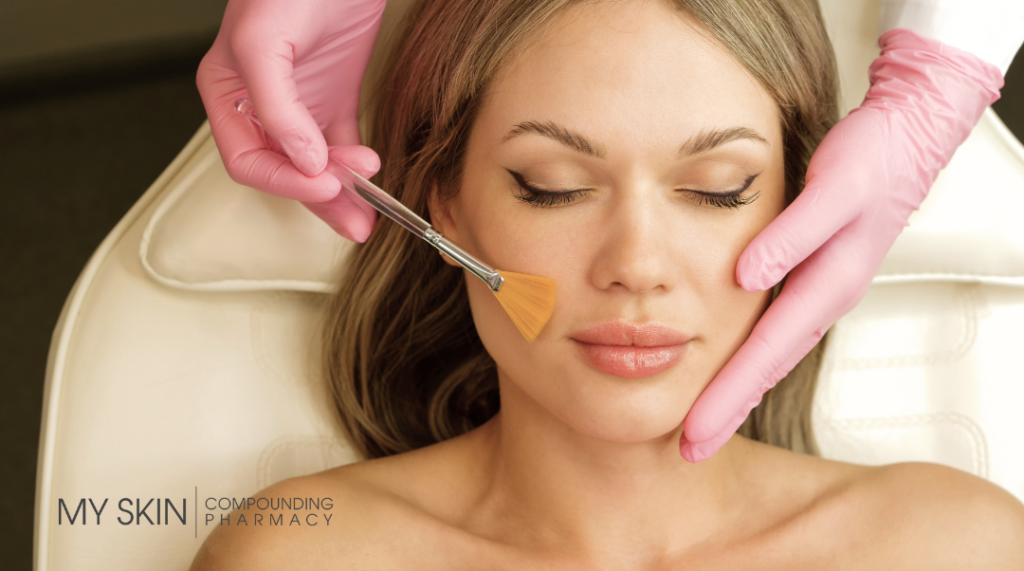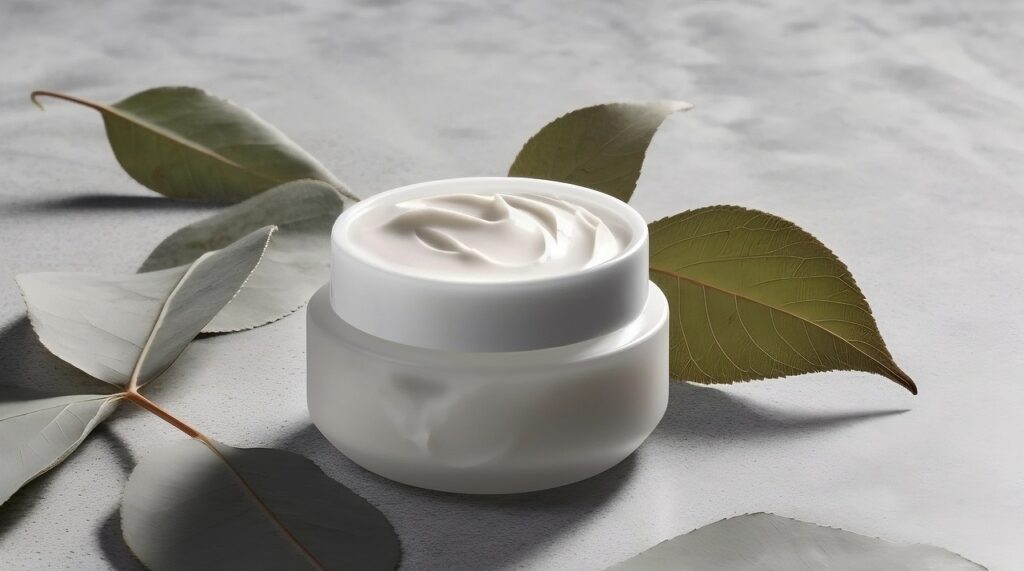Medical peels are a transformative addition to any skin treatment regimen for clinics. When combined with therapies such as laser treatments, needling, mesotherapy, and light therapy, they can enhance your client’s skin like never before. To maximize results, remember to space these treatments two weeks apart , and consider using light therapy immediately after a peel to speed up the healing process. At My Skin Pharmacy, we proudly offer two categories of peels, each tailored to meet diverse skincare needs.
Types of Peels Offered:
- Solution Acid Peels
· Options Include : Lactic, Glycolic, Salicylic, Jessner, TCA, Mandelic, and Resorcinol.
· pH Level : These peels have a low pH of 1-2 and need to be neutralized post-application.
· Best For : Clients with Fitzpatrick skin types I-III who are less prone to post-inflammatory hyperpigmentation (PIH). Lactic and Glycolic peels are safe for pregnant and breastfeeding women. - Mask Peels
· Includes : Tretinoin and cream peels (Lactic, Glycolic, Jessner, TCA).
· Application Duration : Typically left on for 6-8 hours without the need for neutralization.
· Suitability : These peels can be used on all Fitzpatrick scales and are particularly beneficial for those with Fitzpatrick IV and above, who may be more susceptible to PIH.
Achieving Optimal Results
For the best outcome, package your treatments into a series of three peels , applied six weeks apart . Keep in mind that the first peel may trigger a purging effect, especially for clients dealing with acne or pigmentation issues. To prepare skin for a peel, advise clients to use only a gentle wash, moisturizer, and sunscreen for five days before and after the treatment.
Choosing the Right Peel for Your Client
Consider the Skin Issue :
- Acne/Oily Skin : Lactic (good), Salicylic (excellent), Glycolic (excellent), TCA/Jessner (excellent).
- Collagen Growth : Lactic (good), Glycolic (excellent), TCA/Jessner (excellent).
- Uneven Skin Tone and Texture : Lactic (excellent), Glycolic (excellent), Salicylic (good).
- Dry Skin : Lactic (excellent), Glycolic (good).
- Rosacea : Opt for cream peels for gentleness.
Pre-Peel Guidelines:
Two Weeks Prior : Schedule any laser treatments or medical skin services (mesotherapy, microneedling, etc.) to allow for adequate healing.
Five Days Before :
- Encourage patients to stick to a gentle wash, moisturizer, and sunscreen only.
- Advise them to stop using all active skincare products (including tretinoin, retinol, and acids).
- Refrain from shaving, waxing, or exfoliating during this time.
Post-Peel Care:
Five Days Post-Peel :
- Clients may experience itchiness, redness, and tightness; this is normal and should subside.
- Suggest using a healing moisturizer and a high-SPF sunscreen (50+). Encourage them to wear hats and minimize sun exposure.
- Remind them not to touch or pick at their skin and to avoid hot showers or saunas. Peeling may vary in intensity from mild flaking to heavy peeling.
Seven Days Post-Peel :
- For optimal results, suggest starting a prescription-strength night cream every other night.
- They can resume their normal active skincare routine once their skin has returned to baseline, usually around 7 days post-treatment.
1. Solution Acid Peels
Procedure:
- Preparation : Have all tools on hand: hair bands, cotton pads/gauze, cleanser, timer, glass dishes, Vaseline, fan brush, degreasing solution, peel solution, and neutralizer.
- Cleanse : Perform a double cleanse on the skin.
- Degrease : Use degreasing solution or alcohol swabs to ensure the skin is clear of oil.
- Protect Sensitive Areas : Apply Vaseline around the corners of the eyes, lips, and nose.
- Prepare Neutralizer : Combine three capfuls in a dish, placing a cotton pad to soak.
- Prepare Peel Solution : Pour one capsule of the peel solution into a separate dish and moisten a fan brush with it.
- Application : Using even pressure, apply the peel solution with the fan brush to the skin (avoid reapplying to the same area).
- Timing : Set a timer for 1-3 minutes and encourage the client to rate their pain on a scale of 1-10. If the pain exceeds 7/10 , or if any area shows signs of frosting (white opaque patches) or erythema (intense redness), neutralize immediately. Maximum application should not exceed 3 layers for the initial peel.
Layer Application Guidelines for Repeat Peels:
|
Acid Type |
Strength |
Initial Application Time |
Maximum Application Time |
|
Glycolic |
30-70% |
4-7 minutes |
Up to 20 minutes |
|
AHA |
30-70% |
4-7 minutes |
Up to 20 minutes |
|
Salicylic |
10-30% |
1-3 minutes |
Up to 8 minutes |
|
TCA |
10-30% |
1-3 minutes |
Up to 8 minutes |
|
Jessner |
10-14% |
1-3 minutes (single layer) |
Up to 8 layers, up to 8 minutes per layer |
2. Mask Peel (High Strength Prescription Vitamin A)
Procedure:
- Gather Your Supplies : Hair band, cleanser, Vaseline, degreasing solution, and the mask peel.
- Cleanse the Skin : Perform a double cleanse to remove makeup and impurities.
- Remove Oil : Use the degreasing solution or alcohol swabs until the applicator is clear.
- Protect Sensitive Areas : Apply Vaseline around sensitive areas like the eyes, lips, and nose.
- Apply Mask Peel : Use even pressure to knead and massage 2-4 pumps of the mask into your skin, utilizing the warmth from your hands to activate the peel. Follow with another 2-4 pumps applied directly to problematic or hyperpigmented areas using a fingertip.
- Rinse Off : For cream acid peels (Lactic, Jessner, Salicylic, TCA), wash off after 6 hours or if any of the following occur:
· Pain exceeds 7/10 .
· Frosting or redness
· If no issues arise, maintain for the full 6 hours. - For Tretinoin Mask Peels : These should be left on for 6 hours or overnight for optimal results.
- Post-Peel Advice : As always, ensure clients are briefed about post-peel care to maximize benefits.
Final Thoughts
Medical peels are a powerful tool for rejuvenating and transforming the skin. By understanding the different types of peels, their applications, and best practices for pre- and post-care, practitioners can guide their clients to achieve optimal results. Happy peeling, and here’s to beautiful, radiant skin!
Book a 15 minute strategy call with our pharmacist to find how to incorporate peels into your practice.
If you would like to see our extensive compounding list, register here!

Lane Khin, the compounding pharmacist of My Skin Pharmacy, brings a wealth of knowledge from the worlds of pharmacy and dermatology to the table. With degrees in Pharmacy and Applied Science from QUT, Lane combines a deep understanding of compounding and skincare with a friendly, accessible approach. Through My Skin Magazine, Lane shares her expertise, offering readers practical advice and insights into personalised skincare solutions. Lane has a real passion for helping others achieve their best skin.


